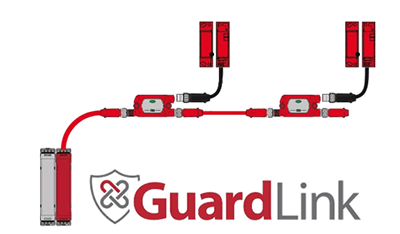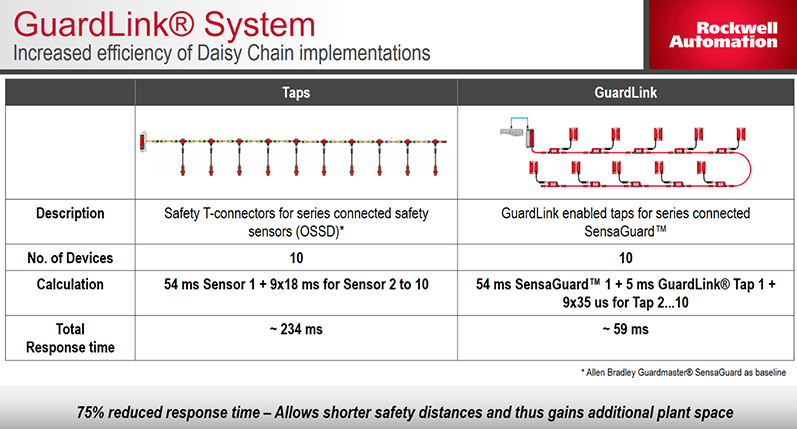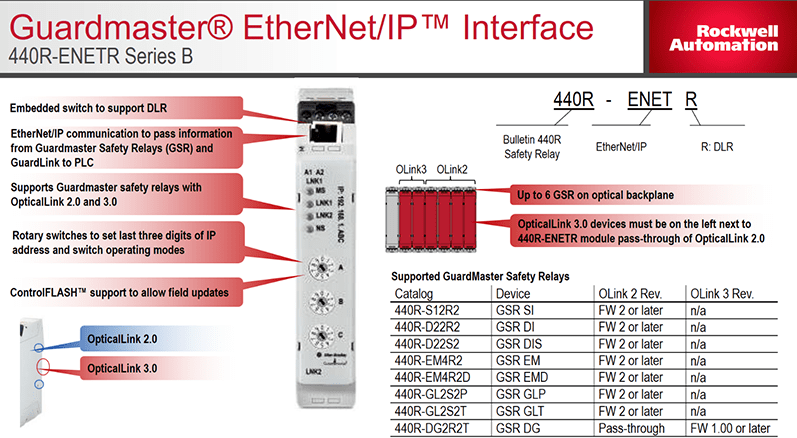
Blog > Automation > 3 Reasons to Upgrade to GuardLink Technology
3 Reasons to Upgrade to GuardLink Technology
1/15/19 | Scott Devost, Rexel Technical Consultant

Blog > Automation > 3 Reasons to Upgrade to GuardLink Technology
1/15/19 | Scott Devost, Rexel Technical Consultant
Have you ever struggled to troubleshoot a safety system on a machine? Traditional safety systems don’t provide much in the way of diagnostics and require someone to go to each door, each e-stop, and each safety device to determine why the machine is shut down. This kind of troubleshooting can require significant downtime and specialized skills. Modern safety systems link GuardLink™ technology with data from individual devices simplify this troubleshooting and increase machine uptime.

The GuardLink system from Allen-Bradley® utilizes smart taps that are monitored by a dedicated safety relay. You can daisy chain up to 32 safety devices in series and still maintain a safety rating of up to PLe. The devices can be light curtains, E-stops, door switches, and locking door switches. You can even send the lock signal to the devices over the same four-pin trunk cable. The trunk can be up to 1,000 meters in distance with a maximum distance between taps of 30 meters and ten meters from the tap to the input device. The GuardLink safety relay will support two separate trunks, just one trunk, or one trunk and a standard safety input on the second channel. And the system reduces the response time of series connected devices from 10 ms to less than one ms per connection.

There are many benefits to Guardlink. Here are the top three reasons to adopt this system.
Understanding individual device status can greatly speed up mean time to repair (MTTR) if a problem occurs within the safety circuit. Without individual switch information, identifying the issue is extremely difficult and costs precious production minutes. Remember, every six minutes of production downtime is 10% productivity lost for that hour, and lost dollars can add up fast when machines aren’t running.
Another challenge with a series wiring of safety devices is knowing which safety input device is open. To receive this notification, you need to run a separate auxiliary output to the PLC. This means more wiring and inputs for the system. The GuardLink safety relay utilizes an optical bus that communicates the status of the safety inputs to the optional EtherNet/IP module. The module is easy to integrate with Studio 5000® version 20 and newer with the available AOP.

Understanding individual device status can be critical to avoiding masked faults when using dry contact devices. Have you ever noticed operators opening and closing random doors around a machine, and then suddenly the safety relay is satisfied? That is fault masking. There is a problem with one of the channels and because the relay eventually sees the transition of the two circuits, it will reset, but the problem is still there. This has been one of the challenges with wiring safety devices in series. With the GuardLink system, each tap is monitored by the safety relay, so fault masking isn’t a concern, and you are able to achieve the highest safety rating of PLe.

Data on the status of individual safety devices can provide insight into how the system is being used vs. how it was designed to be used. Operations Managers and safety professionals have access to dashboards that allow them to identify areas of concern in the system as well as the overall manufacturing process. For example, if a door switch is expected to be cycled two to three times a shift, but is actually being cycled 20 times, this could be a sign of a serious issue.
Individual information from safety devices creates an opportunity to improve both productivity and safety, and the new GuardLink technology makes it easier than ever to gather this information on series wired devices. If you’re interested in learning more and discussing your options, our experienced and talented Automation Specialists are here to help. Contact us today!
Images are © Rockwell Automation®